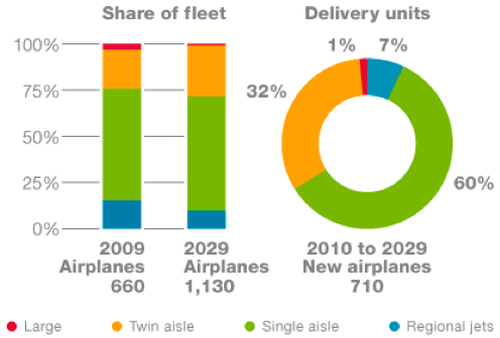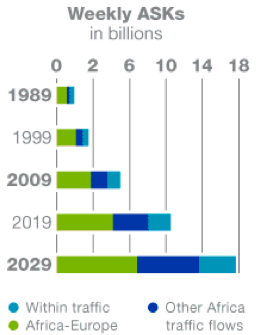African airlines to return to profitability in 2010; Airbus and Boeing see steady aircraft growth
African airlines are projected to return to profitability in 2010 for the first time since 2002 in response to the renewed economic activity and bolstered by what IATA describes as "a decade of cost-cutting, restructuring, and re-engineering." Reflecting these developments, projections for African airline profits stand at a USD100 million profit in 2010, with a breakeven result anticipated for 2011.
According to the IMF, in its Jul-2010 Economic Update, growth in Sub-Sahara Africa is expected to increase by 4.5% in 2010 and 4.9% in 2011, following growth of 2.9%. Growth in Middle East/North Africa is anticipated at 4.5% in 2010 and 4.9% in 2011, following 2.4% growth in 2009.
According to Boeing forecasts, the overall African economy is projected to grow 4.8% in 2010 following 2.9% growth in 2009, with the strong growth resulting from worldwide recovery stimulating demand for African exports as well as imports into the continent. West Africa, buoyed by foreign interest in petroleum development, shows the strongest growth on the continent.
Boeing forecasting need for 710 aircraft in 20-year to 2029
Boeing in Sep-2010 forecast air carriers in Africa will experience steady growth over the next 20 years as air travel in Africa continues to grow with the economy. Boeing's forecast calls for the delivery of 710 airplanes (2.3% of the estimated global total) with a value of approximately USD80 billion for the African airplane market over the next 20 years.
Key data for select African airlines
|
Aircraft type |
New aircraft |
Share by size |
2009 Fleet |
2029F Fleet |
|---|---|---|---|---|
|
Large |
10 |
1% |
20 |
10 |
|
Twin aisle |
230 |
32% |
140 |
310 |
|
Single aisle |
420 |
60% |
400 |
700 |
|
Regional jet |
50 |
7% |
100 |
110 |
|
Total |
710 |
100% |
660 |
1,130 |
Single-aisles to represent 60% of total; twin-aisles 32%: Boeing
Boeing forecasts that twin-aisle aircraft will account for 32% of new airplanes delivered to African carriers over the next 20 years compared to 23% worldwide, while single-aisle airplanes are forecast to represent 60% of the African new aircraft market, compared to 69% worldwide. Regional jets and large aircraft account for a much smaller proportion of the African total, at 7% and 1% respectively.
Africa market value and breakdown estimates: 2010 to 2029
Average African fleet age of 20 years
Most of the African fleet is single-aisle airplanes supporting flights within the continent and between North Africa and Europe, traditionally Africa's principal trading partner. As the demand for African commodities grows and foreign development and tourism increase, African carriers will require a more modernised fleet in order to compete on routes historically dominated by foreign carriers. Africa's current fleet is 19.8 years old on average.
Boeing Commercial Airplanes Senior Market Analyst, Mike Warner, commented: "As the demand for African commodities grows and foreign development and tourism increase, African carriers will require a modernised fleet in order to compete on routes historically dominated by foreign carriers".
Boeing added that capacity is growing strongly, with this trend expected to continue, with intra-Africa growth of 5.7% anticipated over the 2009 to 2009 period, with growth of 8.7% to the Asia Pacific, 7.3% to North America, 4.6% to Europe, 6.5% to Middle East and 5.5% to Latin America.
Africa capacity (ASKs) growth: 1989 to 2019F
Airbus expecting 1,270 deliveries to more than double Africa passenger fleet
Airbus' outlook for Africa is more bullish, with the manufacturing expecting 1,270 aircraft deliveries in the 2009 to 2028 period, comprised of 341 aircraft of under 100 seats and 929 aircraft with more than 100 seats. This represents a more than doubling of the African passenger aircraft fleet.
Airbus added that the fleet growth would be boosted by intra-regional operations, with domestic and intra-regional traffic expected to increase by 5.6% in the 2009 to 2018 period and by 6.2% in the 2009 to 2028 period.
Like Boeing, Airbus sees opportunities arising from the need for replacing older aircraft in the region, particularly in the single-aisle market segment. According to Airbus, nearly 100 (or 17%) old generation passenger aircraft still in service in Africa.
Number of aircraft in service: 1979 to 2009 (Passenger aircraft >100 seats)
Airbus forecast that total Africa traffic is expected to grow by 5.8% in the 2009 to 2018 period and by 5.4% in the 2019 to 2028 period, for a 20-year growth average of 5.6%, above the world average of 4.7%. Growth in freight traffic is anticipated at 4.9% and 4.5% respectively.


